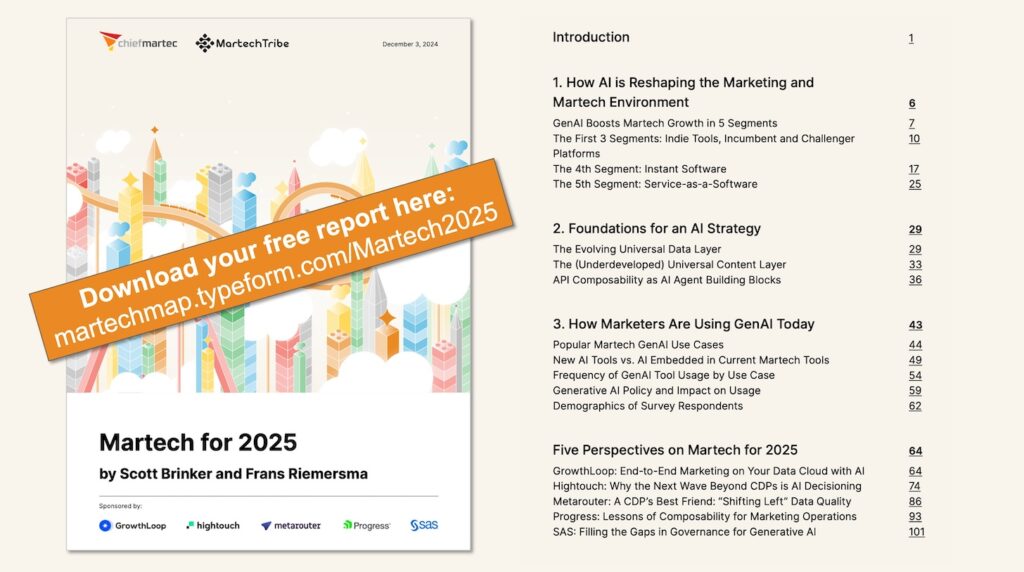Earlier this week I had the honor of presenting at Pivot, a new conference in New York City hosted by Chris Shipley (see 5 reasons to be excited about Pivot). My talk: The Case for a Chief Marketing Technologist. It sparked a number of interesting conversions, both at the conference and around a wonderful article that was written about it on Mashable, Should Your Company Have a Chief Marketing Technologist?
I’ll follow up on some of those points-counterpoints in a subsequent post, but if you’re interested in the presentation slides (and an approximate transcript of the talk), here they are:
The Case for a Chief Marketing Technologist (Transcript)
Life used to be simpler, right?
There was the marketing department, which did, well, marketing. And we all knew what marketing was. Brand positioning? Advertising campaigns? Customer segmentation? That’s marketing. Very clear what marketing was responsible for.
Just like the fire department would fight fires.
Just like the police department would police.
Just like, if it had anything to do with information or technology, it was the responsibility of the IT department. Everything fit into nice neat boxes. And if marketing occasionally needed something from IT, all they had to do was go through the fire department and the police department to get it.
But what if marketing became entwined with information and technology? I mean deeply entwined. Suddenly those boxes aren’t so nice and neat. What would be marketing’s responsibility? What would be IT’s?
Before we answer that question, let’s establish the premise. Sure, there’s lots of technology around — it is the 21st century — but that doesn’t mean marketing is entwined with it. Entwined is a strong word. That’s entwined. So let’s examine the premise.
It wasn’t too long ago that “marketing software” meant Adobe — Illustrator, Photoshop, PageMaker. That was the software most typically bought by marketing departments. But in recent years, the number of marketing software applications has grown…
…exponentially. There’s software for web analytics, social media monitoring, email marketing, bid management, search engine optimization, conversion optimization, landing page management, marketing automation, campaign management, behavioral targeting. Full disclosure, my company, which offers conversion optimization software, is one of the logos up there. And this is just a tiny fraction of what’s available out there.
There are now hundreds of marketing software solutions built for every aspect of marketing today. And I predict that in the years ahead there will be thousands. What’s driving this explosion of marketing technology?
Entrepreneurship. We’re in a perfect storm for marketing technology ventures. Five forces are driving a wave of start-ups and innovative products for marketing.
- The migration of dollars from old media and methods of marketing to new ones — billions of dollars that are shifting around and represent a huge market.
- The cloud computing, which makes many of these applications available through the web — no need for expensive on-premise installation and maintenance.
- The trackable nature of digital makes it easier than ever to justify these new solutions with measurable ROI.
- The disruptive innovation enabled by a greenfield opportunity. There aren’t a few big companies who dominate this space — vibrant competition among hundreds of new ventures.
- And finally, the economics of software are just plain attractive. You can usually build the first version of an idea on a low budget, extend and improve it as demand grows — and at scale, it can be quite profitable.
So you take a large market, with relatively low barriers to entry, that’s becoming easier than ever to sell into, and it’s bound to be alluring to entrepreneurs, funded or bootstrapped alike.
But what’s the significance of all this marketing software? Okay, we’re marketers. Catchy phrases are part of our craft and trade. So we love a good adage, like “you are what you eat.”
Or the advice your mother gave you, “you are the company you keep.”
Well, I have a new maxim for you… you are the software you use.
Think about it. In a digital age, software is our interface to the world. It’s the gateway for our inputs and outputs. The choices those software developers make — and how we choose to buy, configure, adapt, and manipulate their software — in a very real sense delineates our capabilities in this environment.
- Analytics shapes our perception of our audience by how it frames data.
- Automation software guides the evolution of marketing operations.
- Optimization software focuses our attention on particular tactics in the funnel.
- Social monitoring software alerts us to what it thinks is important for engagement.
- Behavioral targeting software helps define the de facto segmentation of our market.
- And CRMs — by the data they collect and the way they structure it — become the blueprint for our relationships with customers.
But wait, there’s more…
Marketing technology isn’t just software you buy. It also encompasses all the myriad of platforms we use to create experiences for our customers and prospects. More than ever, marketing technology is a creative medium.
We’re way beyond the web site. Today we have web-based applications, Facebook apps, iPhone apps, Android apps, iPad apps, ever-more-interactive advertising. We have the semantic web on the horizon. And then there’s the technology that is increasingly embedded into our products and services, connecting marketing with the ongoing customer lifecycle. Each of these is a channel to your audience, and their experiences here impact the position of your brand.
So if we take all of these marketing technologies — the channels we use to reach our audience, the software we use internally to drive our operations, and the always-on features we can tap into in next-generation products and services — well, I think we can appreciate the scale and scope of technology in marketing.
And it’s not just each of these technologies on their own. The real fun is connecting the dots between them — sharing data, coordinating processes, assuring continuity and brand consistency throughout — do we end up with a prince or a frog?
Okay, so we can concede that marketing and technology are entwined. Now I just have one question for you…
Who coordinates this marketing technology ballet at your organization? (Pause to think about that.)
Now some of you might be thinking, “Ballet? The state of marketing technology seems more like a mosh pit!” Fair enough. But even a mosh pit has a certain rhythm and flow. Who’s keeping beat?
Not the IT department. The fundamental problem here is that you can’t separate the marketing from the technology — we’ve already seen they’re entwined. IT doesn’t have marketing skills, and they don’t have the same incentives as marketing. It’s not their fault, but using technology as a creative and marketing medium is just not what IT was structured to do. They can play a role, but they can’t direct this movie.
Not the HiPPO. You’ve heard of the HiPPO, right? The highest-paid person’s opinion. Most senior executives have opinions about technology (and everything else), which is fine, but they usually don’t own the actual implementation of technology. That’s someone else’s responsibility. But who’s exactly?
Not a committee. Sorry, but putting marketers and IT people on the same committee doesn’t resolve the alignment problems between them. It’s a band-aid at best, a political football at worst. And at the end of the day, no committee can deliver the vision and agility of genuine leadership. Just look at the U.S. Congress.
In my opinion, there is only one real solution: Marketing must champion its own technology. We must manage it and lead it as an integrated part of our function.
To do that, we need to tap a new class of marketing professionals: marketers who are also technologists.
One of these marketing technologists should be on the senior management team of marketing, a chief marketing technologist. Someone who is a business/technology hybrid. Someone with a strong technical background in engineering or IT. Someone who is an early adopter, yet understands the pragmatic realities of making new technologies work. And most importantly, someone with that background who is deeply passionate about applying their talents in the service of marketing. As such, the role might be a hybrid of marketing and technology, but their loyalties aren’t divided at all — they report primarily to the CMO, not the CIO.
What would a chief marketing technologist do? Three missions:
Mission #1: Help the CMO translate strategy into technology — with high-fidelity, not the lossy translation we’ve had with IT. And vice versa, proactively recommend emerging technologies that enable new strategies and capabilities.
Mission #2: Choreograph data and technology across the entire marketing organization — there’s tremendous value and efficiency here, waiting to be tapped.
Mission #3: Perhaps most importantly, work to fuse technology into the very DNA of marketing — its practices, people, and culture.
Now, I’m not saying that everyone in marketing needs to be a technologist.
Just as not everyone in marketing has needed to be a “creative.” You can be a brilliant marketer without any skills as a graphic designer.
But just good creative is entwined deeply in the culture and identity of marketing — and collectively we’re very good at leveraging it in our mission — so it needs to be with technology. It’s one of the pillars of new marketing.
Why? You’re already responsible for the outcome — the success and efficacy of your marketing is strongly impacted by the technology in your arsenal and how dextrous you are with it.
If you’re going to be measured on the outcomes that are dependent on technology, shouldn’t you call the shots on that technology? Who should ultimately be in charge of marketing technology? Marketing. And a new breed of marketing technologists, led by a chief marketing technologist, is the way to get there from here.
In summary, if you’re this dependent on marketing technology (see image below) — who do you want packing your parachute?





Great post.I have always fallen between technology and business. My passion is always technology but my degree is in business. I currently do user acquisition, which is basically tech+marketing. I employ highly trackable and tech-driven campaigns to drive new users to different properties and products. A CMT would be the perfect position for me in a few years.
Why wouldn’t the CMT report to CEO? placing them under CMO seems counter to many of your points.
@ Brad, I think the CMT needs to be separate from the CMo as the second mission really requires a champion of its own. The CMO will probably be too busy to work with individuals in an organization and find influencers for each department to help spread the “marketing technology DNA”.
The biggest takeaway is that every marketer must be competent with technology. We can’t rest on our laurels. Even with the next generation of marketers coming out of school, being digital natives, not everyone is a programmer (not many could even string together some javascript code). An understanding of data should be general education for any college-bound individual and not be stashed away in graduate school.